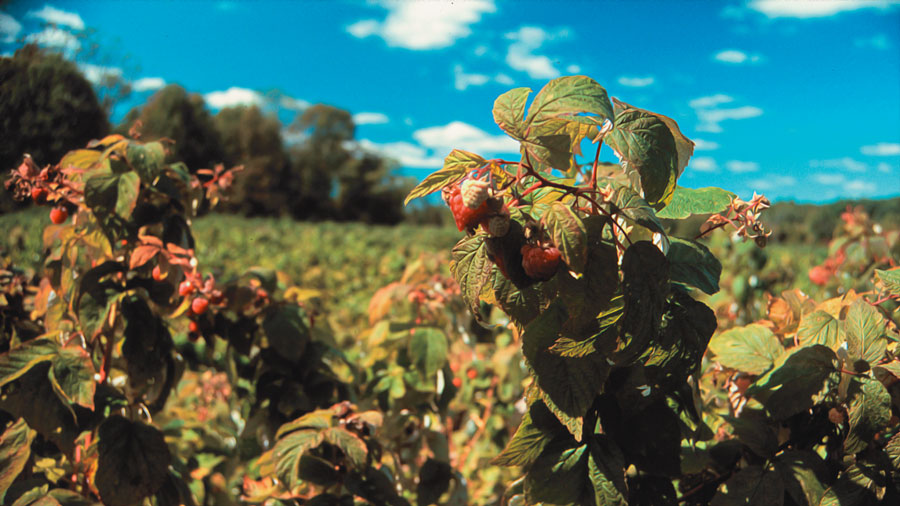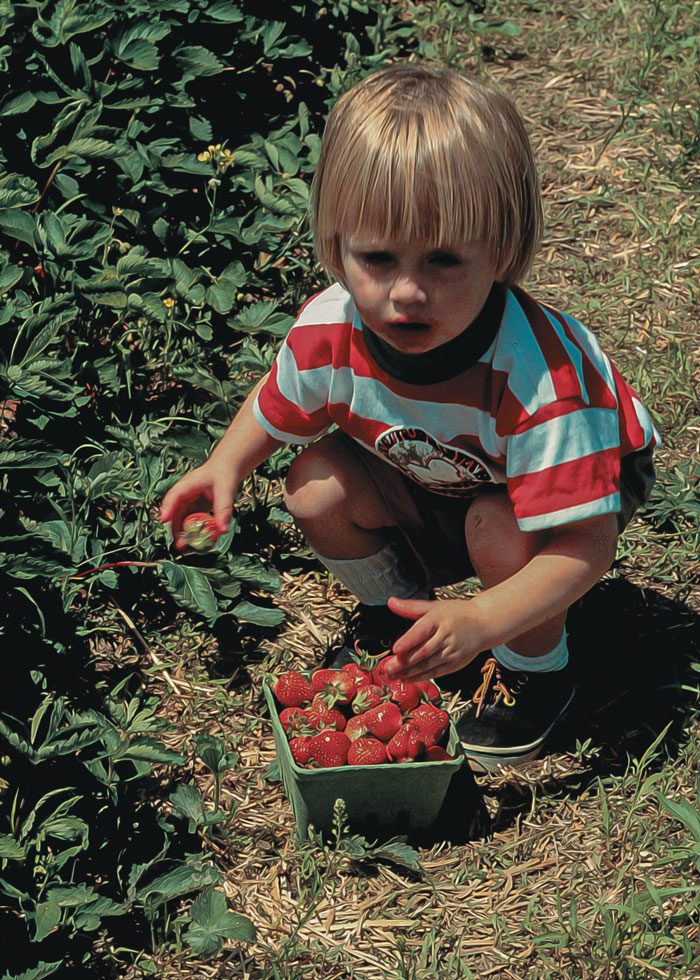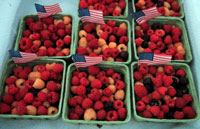Berries may well be the best-loved fruits of summer. As June approaches, so does the season of berries. Beginning with the strawberries and languishing until the frosts of October, berries provide a lengthy time span for berry-lovers in the Skylands region to get out and savor the juicy goodness of a native fruit.

First, let's start with a berry primer. Not all berries are technically, well, berries. Botanically, a berry is "a fleshy fruit containing one or more seeds, which develops from a single ovary". True berries, then, include the blueberry and the cranberry, but also include the tomato and the eggplant! For various reasons involving fruit reproduction, raspberries, blackberries, and all their variations are not true berries, but are aggregate fruits.
However, for our purposes, we need to focus on the common idea of the "berry" in all its glory. Edible berries which can be found in the wild, and/or cultivated, in and around the Skylands region include: blackberry, raspberry, wineberry (Rubus sp.); currant and gooseberry (Ribes sp.); blueberry and cranberry (Vaccinium sp.); huckleberry (Gaylussacia sp.); elderberry (Sambucus sp.); strawberry (Fragaria sp.); and the mulberry (Morus sp.), which actually grows in tree form. The fruits we commonly call "berries" are quite a diverse group, belonging to numerous botanical genera. Additionally, there are multiple varieties of many cultivated berries, thus extending the berry season and allowing for subtle differences in taste, texture, and appearance. Strawberries, raspberries, blackberries, gooseberries, blueberries, and currants are all cultivated crops. They are also all found in the wild in Northwest New Jersey. Mulberry trees can also be found in the wild, as can a form of the cranberry. Huckleberries are a wild berry which resembles the blueberry, and many people use the name interchangeably.
In addition to edible berries, there are many wild berries which are either unpalatable or toxic to humans. Some berries with poisonous qualities include: some nightshade varieties, pokeweed berries, american bittersweet, mistletoe, poison sumac berries, and numerous other berries that may grow on flowers (such as lily-of-the-valley), vines, or bushes. Some of these berries may resemble edible fruits. Thus, it is imperative to consult an accurate, detailed field guide prior to consuming berries in the wild.
While wild berry picking is still possible, many of the old-time berry picking areas have either been developed as residential areas, have been preserved in state or national parks, or are privately owned. There are still some areas that "the locals" know about, and perhaps can be found by talking to long-time residents, or happened upon by chance. The Rubus sp. berries love to grow alongside dirt roads, or at the edge of clearings. Park rangers can provide information about berries in their domain, and whether or not any picking is permitted. Like anything else, too many people can spoil a great berry picking spot, so finding a reliable road-side spot might not be easy! And, just remember that the bears and the snakes enjoy the berries as well, and that many berries do have thorns, so wear appropriate clothing and take precautions. Make noise, bring a whistle and be careful where you reach or step.
Luckily, perfect berries can also be found growing at numerous farms which cultivate them. Some of this produce is sold at roadside stands; some of it finds its way to farmers' markets; some is sold to local restaurants or small grocery stores; and some is grown on farms which have "pick-your-own" berry patches. Some farmers cultivate small plots of several berry varieties, along with other produce; some farmers have more extensive berry patches, with several acres in berry varieties. Both can have retail and "pick-your-own" available. Most large-scale berry production occurs in Central and Southern New Jersey where farmers produce blueberries and cranberries in large quantities.

No matter where or what type of berry you decide to pick or to buy pre-picked, there are some things to know to make the experience more enjoyable. First, call ahead to find out crop and picking conditions. Not all varieties of each berry will be ripe at the same time. Thus, if you are specifically looking for a certain cultivar, such as the Taylor red raspberry, you have to go the third week in July, and not the second. Likewise, if you want to have the most varieties available at once, you need to call and inquire about "peak season". Otherwise, find out if the crop is plentiful and come home with "potluck", which might be the most fun of all! Second, remember that most berries are fragile. Care must be taken when picking them, so as not to mush them, and when storing them, for the same reason. Find out if containers are provided at "pick-your-own" farms, and if not, ask what size is appropriate for the type of berry. If you pick raspberries into a quart container, you will probably end up with a lot of mushy berries on the bottom! Also remember that berries MUST BE PICKED ALREADY RIPENED. They do not ripen after picking. Third, plan on consuming, processing, or freezing berries within a few days of purchase. Raspberries are the most fragile and should be used within 48 - 72 hours, while strawberries and blueberries can probably last a bit longer. All berries can be frozen for future use in baked goods, sauces, jams or jellies, and even wines. Lastly, if you are picking, remember the sunscreen, sturdy shoes, and hat. And because berries are ripe in the heat of summer, don't forget plenty of water.
Now that you know the "what", the "where", and the "how" about berries, let's talk about the "why". Obviously, the best reason is because they taste so good! While many berries taste sweet and refreshing just-picked, others are preferred as jams and jellies, or processed in baked goods. The elderberry is one of the latter category. Nutritionally, berries recently have been in the news for their antioxidant qualities, which are said to improve overall health. The high vitamin A, C, and E content of most berries, along with fiber and essential minerals such as potassium, provide these numerous health benefits. The antioxidant qualities are reported to provide protection against cancer, heart disease, and susceptibility to illnesses. Berries have been used for centuries as natural remedies for everything from stomach upset to urinary tract infections. Berries are also low in calories. Taste plus health benefits are good reasons to enjoy the plethora of berries available to you in the Skylands.
Remember, berry picking is an age-old tradition, enduring through thousands of years. The first settlers in North America were overwhelmed by the array of berries, and the Native Americans provided them with the needed guidance regarding edible fruits and medicinal properties. The cultivation of berries progressed to their hybridization, whereby new types of berries could be created through mixing of the parent genes. For example, raspberry crossed with blackberry has resulted in: marionberries, loganberries, and boysenberries, as well as other varieties! While these particular hybrids do not thrive in this area, and are not generally cultivated by farmers, home gardeners may have some success with them. Some berries, such as the wineberry, were imported from abroad, and now are found plentifully in the wild here in the Skylands.
No matter how berries may technically be classified, berries are the summer fruit. And berries in the Skylands region are, thankfully, quite abundant. So take a trip and indulge in berry picking, or stop at the farmers' market and pick up a few pints. Either way, the June-October berry season, and the wide variety of berries available, will provide much enjoyment all summer!
The New Jersey Farm Bureau provides a list of its member farms, which includes crop and contact information. Another helpful website is the New Jersey Department of Agriculture Jersey Fresh , which lists farmers' markets, roadside stands, and "pick-your-own" operations within each county. This site also provides a "Jersey Fresh" guide to what is in season. Or check our own regional Map and Guide to Farms.
Here is a general guide to ripening times for some local berry types, to get you started:
 Additionally,
the wild varieties can usually be found in July and August as well. The
wild berries will fruit around the same time as the cultivated plants,
but may fruit for longer or shorter periods of time. Remember, the cultivated
varieties have been chosen for specific qualities, such as size, taste,
winter-hardiness, thornlessness, ease of growing, etc., that can affect
the season time/length in comparison to their wild cousins. Mulberries,
elderberries, huckleberries and wineberries are not widely cultivated
by farmers, but many home gardeners do grow them, and they are also abundant
in the wild. Happy berry hunting!
Additionally,
the wild varieties can usually be found in July and August as well. The
wild berries will fruit around the same time as the cultivated plants,
but may fruit for longer or shorter periods of time. Remember, the cultivated
varieties have been chosen for specific qualities, such as size, taste,
winter-hardiness, thornlessness, ease of growing, etc., that can affect
the season time/length in comparison to their wild cousins. Mulberries,
elderberries, huckleberries and wineberries are not widely cultivated
by farmers, but many home gardeners do grow them, and they are also abundant
in the wild. Happy berry hunting!